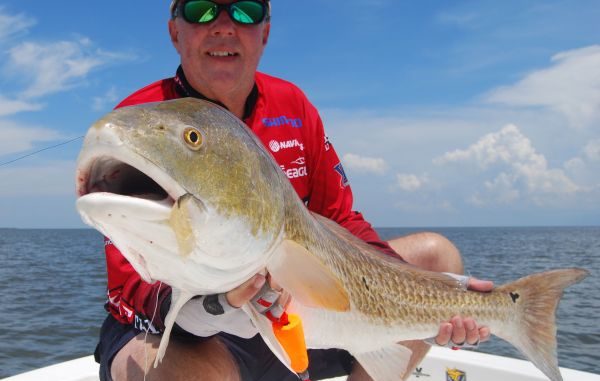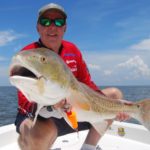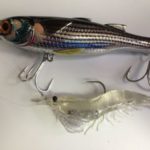
‘Off the chain’ day sees 50-plus bulls caught and released in Quarantine Bay
Gary Abernethy has been lucky enough to fish in a variety of pretty special places, including Montana, the Bahamas and the Florida Keys.
But the bull redfish trip he made late last week out of Buras — where at least 50 big reds came over the gunnels on an epic shoulder-busting day on the water near California Point in Quarantine Bay — will go down as one of his all-time favorite trips.
“I have had the chance over my lifetime as a fisherman to be on lots of water, and that was a Top 10 lifetime fishing day,” said Abernethy, who works with LiveTarget lures as a marketing consultant. “That was a real treat — having 30- or 35-pound fish consistently hit your topwater bait and seeing the nuclear explosion that followed was pretty special.”
Abernethy was in for the Buras Marsh Media Bash, a four-day event held for fishing industry media from across the country hosted by Capt. Ryan Lambert at Cajun Fishing Adventures.
Every single bull on the trip was caught on a LiveTarget artificial lure near California Point, most coming aboard Capt. Joe DiMarco’s 24-foot NauticStar courtesy of a 4 ¾-inch topwater mullet and the incredibly realistic soft plastic rigged shrimp under a popping cork.
With more than 750 lures available, LiveTarget is known for creating realistic, life-like and anatomically-accurate baits that match the hatch in both fresh and saltwater.
“When you can catch close to 15 on a topwater plug and have them just annihilate it, if you’re a fisherman that’s just as good as it gets,” Abernethy said. “Plus, we learned that right along with it, you could use the rigged shrimp under the cork, and they ate that exceedingly well.”
DiMarco, who has guided with Cajun Fishing Adventures for eight years, said water clarity and bait concentration are the two biggest keys to success with big bulls this time of year.
“If you have the presence of finger mullet, baby mullet and menhaden, you’re going to have the same kind of bite we had today, which was off the chain,” DiMarco said. “You just have to follow the bait and look for nervous water.
“You don’t have to have huge flocks of birds to find bait that’s being fed on. Just be observant and watch what the birds are picking up.”
If you’re not throwing live or dead shrimp under a cork, letting the bait tell the story will go a long way to get more hookups, DiMarco said.
“When you start seeing bait flick, or injured bait on the top of the water, there’s fish there. You just have to slowly work down the bank or the reef, and when you start picking them up, zero in on what’s holding them there,” DiMarco said. “If you see a lot of small bait jumping, I would go to a shrimp pattern with an artificial shrimp.
“If you see mullet or menhaden, I would go to a minnow pattern, with a cocahoe minnow or a swimbait. If you match the hatch, that tells you the story of what they’re feeding on.”
At California Point, being able to read the water is critical, DiMarco said.
“You have to see where the bait is holding. Sometimes they have it pushed against the bank. Other times, when you have a low-water situation, they’re going to be off the bank,” he said. “There’s a huge amount of water that flows off California Point, and if the water is moving the bait is moving.
“It’s got access to deep water, which will hold bigger fish because they can fluctuate with temperature changes and salinity levels.”
DiMarco, who recommends using 30-pound braid with a 30-pound mono or fluorocarbon leader to target bulls, said smart boating is also important to catch more reds.
“Don’t be afraid to drift in. It might take you an extra five or 10 minutes to get to the fishing spot, but it will be well worth your time,” he said. “If you see one or two birds and fish blowing up, the worst thing you can do is idle in there and put an anchor down — because you’re only gong to be there five minutes and you’re not going to get a bite. The fish are still there, but you just spooked them.
“They feel the boat in the water, and they feel the anchor. Remember that sound travels twice what it does in water as it does in air.”
With the Mississippi River finally falling after an unusually high summer, DiMarco said salinity levels on the east side out of Buras will steadily rise, and this fall is shaping up to be extra special.
“You have the natural September-October push in the marsh due to the redfish breeding in October,” DiMarco said. “So you’re constantly going to get fresh pushes of fish.
“With the river dropping right now, it’s going to be a godsend in October.”




